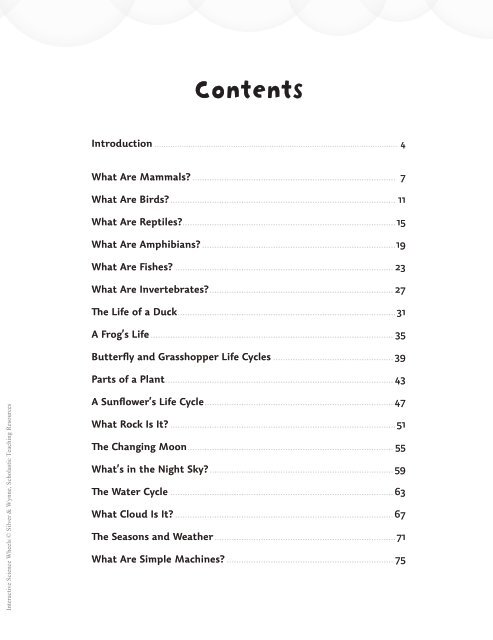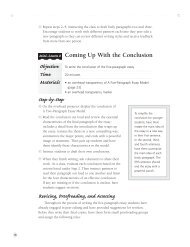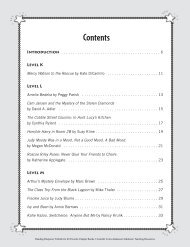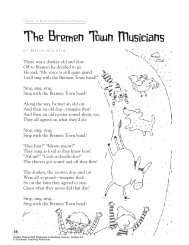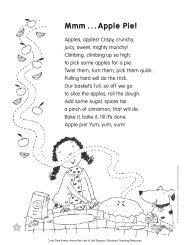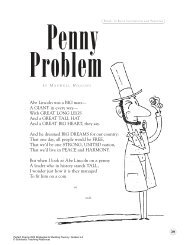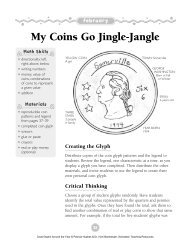Contents - The Scholastic Store
Contents - The Scholastic Store
Contents - The Scholastic Store
Create successful ePaper yourself
Turn your PDF publications into a flip-book with our unique Google optimized e-Paper software.
W h at A r e M a m m a l s ?More To DoMammal ChartChallenge students toresearch the followingmammals: duck-billedplatypus, kangaroo, giantanteater, horseshoe bat,chipmunk, sloth, elephant,rabbit, harp seal, polarbear, zebra, aye-aye. Havethem find out where theseanimals live, what they eat,and what other mammalsare related to them. Make achart of the different groupsof mammals. Invite studentsto draw pictures of theirmammals for the chart.Making the Wheel1 Photocopy pages 9 and 10. Color, if desired.2 Cut out the raccoon and the wheel along the thick outer lines.3 Cut open the cut out window and the small triangular notch onthe raccoon along the thick solid lines.4 Place the raccoon on top ofthe wheel. Push the paperfastener through the centersof both pieces to join them,as shown.Interactive Science Wheels © Silver & Wynne, <strong>Scholastic</strong> Teaching ResourcesResourcesSuper Swimmers:Whales, Dolphins, andOther Mammals of theSea by Caroline Arnold(Charlesbridge, 2007)Beautifully illustratedwhales, dolphins, and othersea mammals will drawyoung readers into the worldof sea mammals.Lions by Jill Anderson(Cooper Square, 2006)Simple text and full-colorphotos offer a glimpse intothe life of a lion family.http://naturemappingfoundation.org/natmap/facts/mammals.htmlClick on a photo or ananimal name to findout cool facts about themammal.8Teaching With the WheelAsk students if they have a pet dog, cat, hamster, gerbil, guinea pig,or mouse. Explain that such pets are mammals. Invite students todescribe their pets. Ask: How big are they? What covers their body? Whatdo they like to eat? Encourage students to bring in and share photosof their pets. To learn more about mammals and where they live,invite students to color, make, and read their wheels. <strong>The</strong>n check forunderstanding by asking them these questions:1 What are mammals? (Mammals are the only animals that grow hairor fur. <strong>The</strong>y make their own body heat to keep warm. <strong>The</strong>y breathe airthrough lungs.)2 What do mammals feed their babies? (Milk they make)3 Name some animals that live in the grasslands [or other habitat].(Giraffe, bison, lion)
What Are Mammals?What AreMammals?Mammals are the only animals thatgrow hair or fur. <strong>The</strong>y maketheir own body heat to keepwarm. <strong>The</strong>y breathe airthrough lungs. Mammalslive everywhereon earth.Cut outMammals make milkto feed their babies.<strong>The</strong>y take care oftheir young.Interactive Science Wheels © Silver & Wynne, <strong>Scholastic</strong> Teaching Resources9
What Are Mammals?OceanDesertGorillaWater buffaloLionBisonLeopardGiraffeJackrabbitInteractive Science Wheels © Silver & Wynne, <strong>Scholastic</strong> Teaching ResourcesWoodsCamelDolphinKangarooManateeGreatblue whalePolar regionsWolfMooseGrasslandsSealWalrusPolar bearRain forest10
W h at A r e S i m p l e M a c h i n e s ?Interactive Science Wheels © Silver & Wynne, <strong>Scholastic</strong> Teaching ResourcesMore To DoSimple SearchTake the class on a walkaround the school in searchof simple machines. Havestudents look for inclinedplanes (ramps, ladders),levers (door hinges,faucets), pulleys (flagpole),and wedges (doorstops,forks). When they findsomething that they thinkis a simple machine, havethem draw it, explain whatkind of machine it is, andrecord where they found it.ResourcesSimple Machines by AllanFowler (Children’s Press,2001)This introductory bookdescribes simple machinesand shows how peopleuse them.Forces Make Things Move byKimberly Brubaker Bradley(Collins, 2005)Colorful illustrationscombined with simple texthelp students understandwhy forces must be appliedto make simple machineswork.http://www.edheads.org/activities/simple-machines/index.shtmlSet kids on a scavengerhunt to search for simplemachines around this virtualhouse. To access the game,click on Start, then on<strong>The</strong> House.76Making the Wheel1 Photocopy pages 77 and 78. Color, if desired.2 Cut out the two pieces along the thick outer lines.3 On the what are simple machines? piece, cut open the windowsand the four triangular notches along the thick solid lines. Foreach window, make sure you cut two sides only; do not cut thedashed fold lines.4 Place the circle with windowson top of the wheel with thetabs. Push the paper fastenerthrough the centers of bothpieces to join them, as shown.Teaching With the WheelInvite students to color, assemble, and read their wheels. Have themturn the tabs until number 1 on the tab matches number 1 on the topcircle. Have students read about levers, then open the window to findanother example of a lever. Repeat for tabs 2, 3, and 4. <strong>The</strong>n check forunderstanding by asking students these questions:1 What do simple machines do? (Simple machines make work easier.)2 Name four kinds of simple machines. (Lever, inclined plane, wedge,and pulley)3 Explain what each machine is used for. (A lever is used to lift, lower,or move something. An inclined plane is used to move something up ordown. A wedge is used to push things apart. A pulley is used to lift orlower something.)4 Name an example of each kind of machine. (Answers will vary.)
What Are Simple Machines?What AreMove a loadup or down aninclined plane.LEVERSeesawSimple Machines?A lever lifts,lowers, ormoves a load.INCLINEDPLANEPULLEYCraneA wedgepushes thingsapart.AxeInteractive Science Wheels © Silver & Wynne, <strong>Scholastic</strong> Teaching ResourcesRampSimple machinesWEDGEPull ona pulley tolift or lowera load.make work easier.77
What Are Simple Machines?BottleopenerRollercoasterFlagpoleInteractive Science Wheels © Silver & Wynne, <strong>Scholastic</strong> Teaching Resources78Knife


